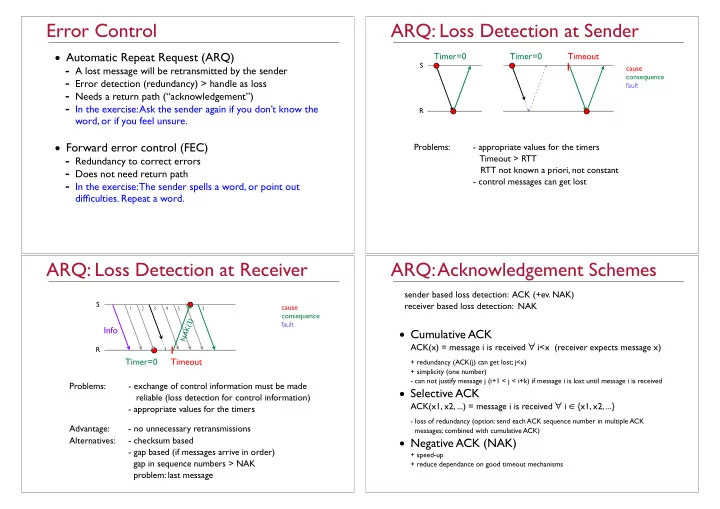

Error Control ARQ: Loss Detection at Sender • Automatic Repeat Request (ARQ) Timer=0 Timer=0 Timeout - A lost message will be retransmitted by the sender S cause consequence - Error detection (redundancy) > handle as loss fault - Needs a return path (“acknowledgement”) - In the exercise: Ask the sender again if you don’t know the R word, or if you feel unsure. • Forward error control (FEC) Problems: - appropriate values for the timers - Redundancy to correct errors Timeout > RTT - Does not need return path RTT not known a priori, not constant - control messages can get lost - In the exercise: The sender spells a word, or point out difficulties. Repeat a word. ARQ: Loss Detection at Receiver ARQ: Acknowledgement Schemes sender based loss detection: ACK (+ev. NAK) S receiver based loss detection: NAK cause 1 2 3 4 5 3 consequence NAK(3) fault Info • Cumulative ACK ACK(x) = message i is received ∀ i<x (receiver expects message x) R Timer=0 Timeout + redundancy (ACK(j) can get lost; j<x) + simplicity (one number) - can not justify message j (i+1 < j < i+k) if message i is lost until message i is received Problems: - exchange of control information must be made • Selective ACK reliable (loss detection for control information) ACK(x1, x2, ...) = message i is received ∀ i ∈ {x1, x2, ...} - appropriate values for the timers - loss of redundancy (option: send each ACK sequence number in multiple ACK Advantage: - no unnecessary retransmissions messages; combined with cumulative ACK) • Negative ACK (NAK) Alternatives: - checksum based - gap based (if messages arrive in order) + speed-up gap in sequence numbers > NAK + reduce dependance on good timeout mechanisms problem: last message
ARQ: Retransmission Schemes 1 ARQ: Retransmission Schemes 2 • Independent of strategies used for loss detection and Go-Back-N S 1 2 3 N 1 2 3 acknowledgement generation! (w/o window) • ARQ Protocols - Stop and Wait R - Go-Back-N - Selective Retransmission Sender Resend all sent but not ack:ed PDUs. • Pipelining: sender allows multiple unacknowledged pkts Timeout: � 1 single timer (oldest not ack:ed PDU) � ACK > reset timer Reciever PDU in-order: send ACK, deliver to application PDU out-of-order: send ACK of last in-order PDU. � cumulative ACK natural � not buffered ARQ: Retransmission Schemes 2 ARQ: Retransmission Schemes 3 Go-Back-N (w/o window) Selective Repeat S 1 2 3 N 1 N+1 N+2 - no need for a queue at the receiver (w/o window) - inefficient use of transmission capacity R S Sender Resend only oldest not ack:ed PDU. 2 3 1 2 3 N 1 selective ACK > Timeout: Individual timers cumulative ACK > Timeout: one timer Reciever PDU: individual ACK (in-order or not) Buffer out-of-order PDUs R
ARQ: Retransmission Schemes 3 ARQ: Efficiency Selective Repeat (w/o window) Stop & Wait Go-Back-N Selective Repeat - Selective ACK: Retransmission of message i if NAK(i) or TOi - Cumulative ACK: • TOi > send message i ; TOj=0 ∀ i � j � k 1 1 1 ! ! ! • avoid unnecessary retransmissions 2 2 • burst errors > requires several RTT to retransmitt all lost messages 3 3 - messages in receiver buffer have to be reordered (high buffer 1 1 1 storage) 2 4 3 5 S 1 2 3 N 1 N+1 N+2 efficiency = channel usage for successful transmissions · · T put = (1 − p ) T 1 − p T put = (1 − p ) T T put = (1 − p ) T T + 2 P = 1 − p T + p · 2 P = = 1 − p ! T 1 + 2 A 1 + p · 2 A R T: Transmission time (size/rate) � � � A = P/T: measure about un-ack:ed messages � P: Propagation time (distance/speed) �� (Satellite: A>>1; LAN: A � 0) ARQ: Timeout Forward Error Correction (FEC) • Transmit redundant information that can be used to reconstruct lost or erroneous packets at the receiver. Tput • Advantage: avoidance of retransmissions. This is meaningful for long communication delays (satellite link, compact disc). • Problem: redundant information is not efficient. schematic figure unnecessary unnecessary Timeout • Example 1: Redundancy retransmissions waiting - Messages T1,T2,T3 - send T1,T2,T3,R1,R2 with R1=T1 ⊕ T2, R2=T2 ⊕ T3 • Example 2: Error correcting codes - e.g., Hamming code
Error Control in TCP • Loss detection: sender based (Timer) - adaptive timeout calculation - triple duplicate ACK • Acknowledgement: cumulative ACK - sequence number: next octet that the receiver expects to get. - variable message length; retransmitted messages can include more than the original. • Retransmision: (no specification) - until 1987: GBN - since 1987: Selective Retransmit - proposed modification: selective ACK
Recommend
More recommend